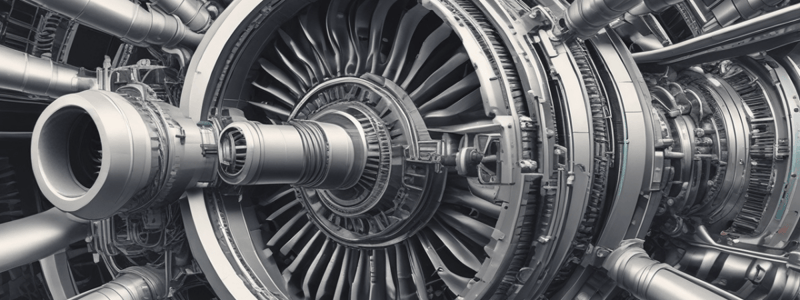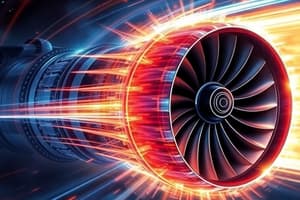Podcast
Questions and Answers
What do engine symbols such as Pt and Tt often accompany?
What do engine symbols such as Pt and Tt often accompany?
- Engine serial numbers
- Engine type designations
- Station numbers (correct)
- Manufacturer logos
What is the purpose of the pressure ratio, or EPR?
What is the purpose of the pressure ratio, or EPR?
- To indicate thrust to the pilots (correct)
- To indicate airspeed
- To check fuel flow
- To monitor oil pressure
What is the purpose of station numbers?
What is the purpose of station numbers?
- To identify engine serial numbers
- To locate the position of temperature and pressure sensing (correct)
- To indicate engine performance
- To locate the position of engine components
What does the prefix T refer to?
What does the prefix T refer to?
What is the term for the temperature at Station 5?
What is the term for the temperature at Station 5?
What is Ps3?
What is Ps3?
Why are station numbers used?
Why are station numbers used?
What is the difference between Pt and Ps?
What is the difference between Pt and Ps?
What is the purpose of total temperature (Tt)?
What is the purpose of total temperature (Tt)?
What is a potential issue with using station numbers?
What is a potential issue with using station numbers?
Flashcards are hidden until you start studying
Study Notes
Forces and Work
- Force (F) can be calculated by multiplying pressure (P) and area (A): F = P × A
- Example: F = 6 psi × 300 in² = 1800 lb (force in pounds)
- The force mentioned is present in addition to reactive thrust in most gas turbine engine designs.
Work
- Work is done when a force acting on a body causes it to move through a distance.
- The formula for work is: W = F × d (where W is work in foot-pounds, F is force in pounds, and d is distance in feet)
- A force can act on an object:
- Vertically (opposite the effect of gravity)
- Horizontally (90° to the effect of gravity)
- Anywhere in between the two
Power
- Power depends on three factors:
- Force used
- Distance the force moves
- Time required to move the force
- Power is measured in foot-pounds per second, foot-pounds per minute, or mile-pounds per hour.
- Power is the rate at which work is performed.
Newton's Third Law
- Newton's Third Law of motion states: "For every action, there is an equal and opposite reaction."
- Example: a jet engine accelerating a mass of air backwards produces an equal amount of force that moves the aircraft forward.
- The law is best understood by observing a deflating balloon.
Bernoulli's Theorem
- Bernoulli's principle finds that if air is passed through a venturi:
- As the air velocity increases, the pressure decreases
- As the velocity decreases, the pressure increases
Gas Turbine Engines
- The history of propulsion began in 1930 with Frank Whittle's thesis advocating the use of the gas turbine engine.
- Whittle patented the first turbojet aircraft engine, which used a compressor impeller, driven by a turbine.
- The engine developed was a pure reaction turbojet, where the total thrust came from reaction to the hot gas stream emitted from a propelling nozzle.
The Gas Turbine Engine
- The aircraft gas turbine is a heat engine using air as a working fluid.
- It consists of a compressor, combustion chamber, and turbine for extracting energy from the high-velocity exhaust gases.
- The turbine-type jet and gas turbine engine is a family of engines based on the Whittle design.
Engine Constructional Configurations
- All gas turbine engines consist of seven basic components:
- Air inlet
- Compressor section
- Combustion section
- Turbine section
- Exhaust section
- Accessory section
- Ancillary systems
- Ancillary systems are required for starting, lubrication, fuel supply, anti-icing, cooling, and pressurization.
Engine Performance Stations
- Engine performance stations are used to locate the position of temperature and pressure sensing.
- Station numbers are used to describe locations and functional data of the engine.
- Prefixes are used to show various parameters occurring at these stations within the engine, such as temperature (T) and pressure (P).
Studying That Suits You
Use AI to generate personalized quizzes and flashcards to suit your learning preferences.



